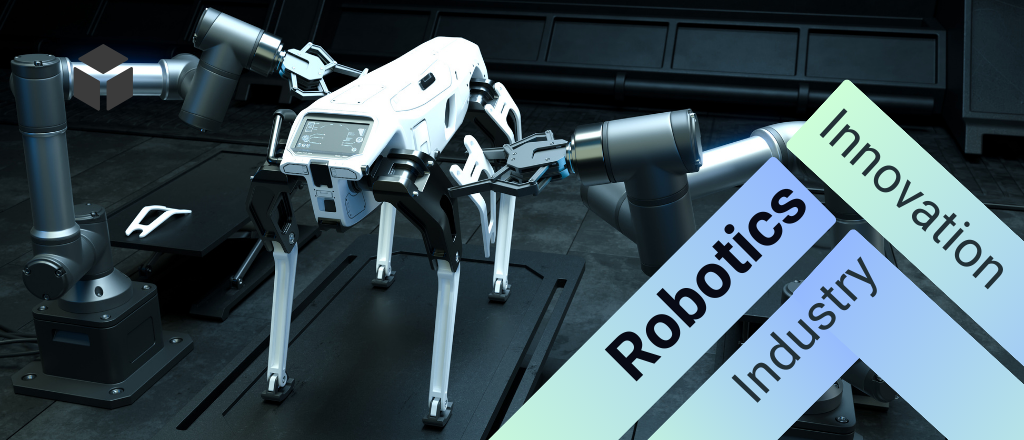The Transformative Impact of Robotics on Industry Automation- Revolutionizing Efficiency, Precision, and Innovation Across Sectors
Robotics and industrial automation are at the heart of Industry 4.0, revolutionizing manufacturing in recent years. These technologies dramatically enhance versatility and reliability, allowing businesses to adapt quickly to changing demands while maintaining utmost precision and efficiency to streamline operations, reduce downtimes, and optimize resource usage. Robotics are driving productivity and boosting profitability across a wide range of industries.
Digital Twins: Accelerating Robotics Innovation with Virtual Precision
One of the most exciting trends reshaping industrial automation is the rise of digital twins—virtual models that mirror physical robotic systems down to minute details. This technology unlocks a new level of insight and control, without ever touching the shop floor.
Key Advantages of Digital Twins in Robotics:
- Risk-Free Experimentation: Digital twins allow engineers to simulate a wide range of operating scenarios, uncovering potential weaknesses and fine-tuning performance long before any hardware is deployed. Imagine testing every variable, from environmental factors to rare edge cases, without the cost of trial-and-error in real life.
- Predictive Maintenance: By continuously monitoring robotic systems in their virtual form, maintenance teams can spot early warning signs of wear or malfunction. This proactive approach minimizes unplanned downtime and extends the lifespan of critical assets—a win for efficiency and the bottom line.
- Enhanced Optimization: Digital twins serve as a live blueprint for ongoing improvement. Whether it’s improving throughput on an assembly line or reconfiguring movements for greater precision, teams can analyze virtual data, test adjustments, and roll out enhancements quickly and confidently.
As robotic technologies become more complex and widespread, digital twins are fast becoming indispensable for CPG, food and beverage, and beyond. By bridging the gap between physical equipment and virtual insight, organizations can innovate faster, operate smarter, and keep risk at bay.
Harnessing Digital Twin Technology: Virtual Simulations for Smart Robotics
One of the most exciting frontiers in robotics is the use of digital twin technology—virtual models of physical robotic systems that allow organizations to simulate, monitor, and optimize performance in real time, without ever touching hardware.
Why Digital Twins Matter for Robotics
Digital twins introduce a range of strategic benefits that are reshaping how companies design and manage robotic systems within manufacturing and logistics environments:
- Risk-Free Testing: Businesses can trial new workflows or identify weak points in automation processes by running detailed simulations, long before implementing changes on the factory floor.
- Performance Tuning: Engineers leverage these virtual ecosystems to refine robot movements, improve throughput, and fine-tune for different product variants, ensuring deployed solutions are as efficient as possible.
- Proactive Maintenance: Through continuous virtual monitoring, digital twins forecast mechanical wear and potential points of failure, enabling predictive maintenance that reduces costly downtime and unexpected stoppages.
Whether it’s minimizing downtime at a food processing plant or optimizing warehouse logistics for global retail brands, digital twin simulations have unlocked a new level of agility and reliability in robotics. As this technology matures, businesses can expect even greater speed-to-market for product launches, and safer, more cost-effective pathways to automation at scale.
Mobile Manipulators: The Next Leap in Industrial Automation
As we look to the near future, mobile manipulators are stepping firmly into the spotlight as a transformative force in industrial operations. But what exactly are they? In simple terms, mobile manipulators combine a mobile robotic base—often found scooting around warehouses—with a dexterous robotic arm capable of delicate and precise tasks. Think of them as the multitaskers of the factory floor, seamlessly blending movement and manipulation.
Expanding the Boundaries of Automation
The integration of mobility with advanced manipulation opens up new horizons for efficiency and flexibility. Traditionally, robotic arms were anchored to one spot, limiting their utility. Mobile manipulators, however, can travel throughout a facility, navigating around obstacles and adapting to ever-changing production needs. This mobility allows them to:
- Transport and reposition materials autonomously, reducing manual labor.
- Perform repetitive or ergonomically challenging tasks such as assembly, fastening, or packaging.
- Tackle handling and manipulation operations that require both speed and a gentle touch, such as in electronics or food processing.
Enhancing Productivity and Reducing Costs
Industries that rely on agility and precision—think automotive, electronics, and food & beverage—are already seeing the benefits. These robots not only speed up workflows and minimize errors, but they also help alleviate labor shortages by filling in for repetitive, physically demanding tasks. As their adoption grows, businesses are experiencing:
- Decreases in operational costs due to fewer manual interventions and improved reliability.
- Boosts in productivity as bottlenecks caused by fixed automation solutions are eliminated.
- Greater adaptability when responding to shifts in consumer demand or production requirements.
Mobile manipulators are rapidly becoming essential for forward-thinking manufacturers seeking smarter, more adaptable automation solutions.
Industries Harnessing the Power of Mobile Manipulators
Mobile manipulators are steadily becoming a linchpin for innovation in several sectors, thanks to their unique blend of flexibility and precision. Manufacturers are leveraging these agile robotic solutions to boost throughput on assembly lines, streamline packaging operations, and meet the relentless demands of just-in-time production.
In the logistics arena, organizations such as DHL, FedEx, and Amazon are embracing mobile manipulators to automate material handling, keep warehouses humming round the clock, and swiftly respond to peak seasonal surges. Meanwhile, the automotive and electronics industries are utilizing them for tasks like intricate part assembly and quality checks, reducing bottlenecks and enhancing worker safety.
Healthcare facilities and pharmaceuticals also benefit—mobile manipulators assist with handling sensitive equipment or transporting medical supplies, cutting down on manual labor and minimizing contamination risks.
Ultimately, any industry that requires a winning combination of autonomous mobility, dexterous manipulation, and operational scalability can find transformative value in mobile manipulators. From food processing plants to high-tech manufacturing hubs, these robots are shaping the future of efficiency and adaptability.
The Expanding Role of Mobile Manipulators Across Industries
Mobile manipulators are rapidly finding their stride as essential players across a spectrum of industries. From automotive assembly plants to logistics hubs, their unique blend of mobility and dexterity enables them to tackle diverse tasks with remarkable efficiency.
- Dynamic Material Handling: In bustling warehouse environments, mobile manipulators transport goods, organize inventory, and navigate ever-changing layouts with ease—think of them as a flexible link between storage, packing, and shipping lines.
- Repetitive Assembly Tasks: On factory floors, these robots take on everything from fastening bolts to complex product assembly, supporting high-mix, low-volume production typical in automotive or electronics sectors. Their precision minimizes errors and accelerates throughput.
- Packaging and Order Fulfillment: In consumer packaged goods and e-commerce, mobile manipulators automate packaging processes and streamline order picking, handling both fragile and varied items without breaking a sweat.
- Safe Operations in Hazardous Environments: In industries such as chemicals, pharmaceuticals, and even defense, their ability to operate autonomously in areas unsafe for human workers adds a layer of safety while keeping productivity high.
As more enterprises invest in flexibility and responsiveness, mobile manipulators are emerging as the linchpin for efficient, agile operations—helping organizations maximize productivity, contain costs, and adapt to ever-evolving industrial demands.
Advancements in Humanoid Robot Mobility and Versatility
As robotics continues its rapid evolution, humanoid robots are stepping confidently into more complex and dynamic roles thanks to significant breakthroughs in both mobility and adaptability.
Modern humanoid robots are now capable of tasks that were once squarely in the realm of science fiction. Through advanced actuators, refined motor controls, and sophisticated balance algorithms, these robots can traverse uneven surfaces, climb stairs, and maneuver around obstacles with unprecedented finesse. The leap from rigid, predictable movements to fluid, human-like motion is reshaping possibilities in industries like healthcare, elder care, and hazardous environment operations.
But it’s not just about putting one foot in front of the other. The new generation of humanoid robots brings a toolkit of adaptable hands, arms, and sensory inputs—enabling them to open doors, manipulate delicate objects, or reach high shelves. Integration of state-of-the-art AI, like the solutions developed by Boston Dynamics and SoftBank Robotics, lets these robots learn and respond to new tasks quickly, customizing their actions for each environment or user.
The result? An exponential increase in both the range and value of services humanoid robots provide. Whether supporting overworked medical staff, taking on search-and-rescue assignments, or performing precise inspections in hazardous settings, these machines are not just keeping up—they’re setting new standards for automation’s reach and potential.
An Analysis of How Robotics Technology is Changing the Consumer Packaged Goods (CPG) and Food and Beverage Industries
Key Impact Areas: Supply Chain Optimization, Predictive Maintenance, Quality Control, Production Optimization, Adaptive Manufacturing
Technological advances in robotics are helping CPG companies improve accuracy, reduce costs, and maintain consistent quality while meeting increasing consumer demand for product variety and customization.
- Supply Chain Optimization:
Autonomous mobile robots (AMRs) and Automated Guided Vehicles (AGVs) streamline material handling, inventory movement, and packing, while robotic systems improve warehousing with smart storage and retrieval solutions. - Predictive Maintenance:
Robots equipped with sensors monitor equipment health, enabling predictive maintenance and reducing downtime in manufacturing and supply chain operations. - Improved Quality Control through Advanced Inspection Systems:
Robots with AI-powered vision systems and machine learning perform real-time quality inspections, identifying packaging defects, inconsistencies, and contamination, ensuring superior quality standards through automated testing and sampling. Harnessing advanced artificial intelligence (AI) and machine learning (ML), these next-generation robots take quality control to new heights by interpreting vast amounts of data on the fly and making rapid, informed decisions that drive consistency and reliability.Key Developments in Robotic Quality Control- Enhanced Autonomy: Modern robots now recognize patterns, predict faults, and carry out advanced planning during inspection processes—minimizing human intervention and improving accuracy.
- Real-Time Adaptation: AI enables robots to dynamically adjust inspection criteria in response to changes in packaging materials, product types, or environmental factors, ensuring continued compliance with stringent quality standards.
- Seamless Connectivity: Improved human-robot interfaces allow for more intuitive monitoring, reporting, and adjustment, making it easier for teams to fine-tune quality control processes on the factory floor.
With these capabilities, robotics not only streamline inspections but also continuously learn and evolve, driving higher levels of assurance and efficiency for manufacturers across the consumer packaged goods and food and beverage sectors.
- Manufacturing Production Line Optimization:
Collaborative robots for assembly tasks, high-speed packaging automation, smart labeling and coding systems, flexible manufacturing systems and predictive maintenance capabilities. These advancements are not only increasing throughput, but also transforming how factories operate day-to-day.The Evolution of Robotics: Greater Autonomy and Ease of UseBy 2025, robotics technology is expected to deliver even greater value to CPG and food and beverage manufacturers:- Increased autonomy: Robots are integrating advanced software and sensors, enabling them to handle more complex tasks and swiftly adapt to real-time changes on the factory floor—without constant human intervention.
- Ease of use: Programming collaborative robots (cobots) is becoming so intuitive and user-friendly that even non-experts can configure and deploy them. This opens the door for small and medium-sized enterprises (SMEs) to benefit from automation that was once only accessible to industry giants.
- Enhanced safety: Built-in safety features and state-of-the-art technological developments ensure secure interaction between robots and human operators, even in demanding or high-risk environments.
These innovations empower manufacturers to respond to shifting consumer preferences, streamline production, and maintain the highest safety and quality standards—ultimately boosting flexibility, sustainability, and profitability.
- Adaptive Manufacturing:
Robotic systems can quickly adjust to produce different products or packaging formats, enabling manufacturers to respond swiftly to changing consumer demands and market trends while reducing material waste, contributing to cost efficiency and sustainability.
Sustainable Robotics: Building a Greener Future
As robotics continues to advance across industries, sustainability has become more than just a buzzword—it’s a business imperative. Next-generation robots are being engineered with sustainability in mind, supporting not just operational efficiency but also environmental responsibility.
Why Prioritize Sustainability in Robotics?
The answer is twofold: first, sustainable robotics directly reduces environmental impact by minimizing resource usage and waste throughout a robot’s lifecycle. By incorporating recyclable and biodegradable materials, manufacturers lessen their ecological footprint while meeting rising regulatory and consumer expectations.
Second, advances in energy management—such as efficient battery systems and smarter power usage—lower the carbon emissions associated with robotic operations. This push for greener, smarter machines dovetails with global initiatives to combat climate change and foster long-term resource security.
In practice, this means that many robotics manufacturers now emphasize:
- The use of recyclable or responsibly sourced materials,
- Enhanced energy efficiency in both operating systems and supporting infrastructure,
- Adoption of closed-loop manufacturing processes that reduce waste.
Incorporating sustainability isn’t just about “doing the right thing”—it helps future-proof organizations against tightening regulations and shifting customer preferences.
By placing sustainability at the core of robotics development, companies position themselves to lead in a world where innovation and environmental stewardship go hand in hand.
Humanoid Robots: Shaping the Future of Service Robotics in 2025
Humanoid robots are taking center stage in the evolution of service robotics, offering capabilities that were once the realm of science fiction. Thanks to breakthroughs in mobility, dexterity, and artificial intelligence, these sophisticated machines are stepping into diverse environments—from hospitals to hazardous industrial sites—enhancing both productivity and safety.
- Adaptive Mobility: Next-generation humanoids now expertly navigate cluttered spaces, ramps, and tight corridors, making them valuable assets where their human-like form can interact seamlessly with people and surroundings.
- Flexible Task Performance: Their design enables them to perform a wide array of service tasks, such as assisting with patient mobility in healthcare settings, supporting elderly care, or taking on repetitive and dangerous operations in facilities that demand human-level interaction.
- AI-Driven Personalization: Modern humanoids leverage AI to learn and adapt in real time, customizing their behaviors to fit the specific protocols or preferences of a workplace—further expanding their utility in dynamic settings.
As these robots become more accessible and investments accelerate, expect to see humanoids playing a vital role—not just as tools, but as true partners—alongside humans in the service sector.
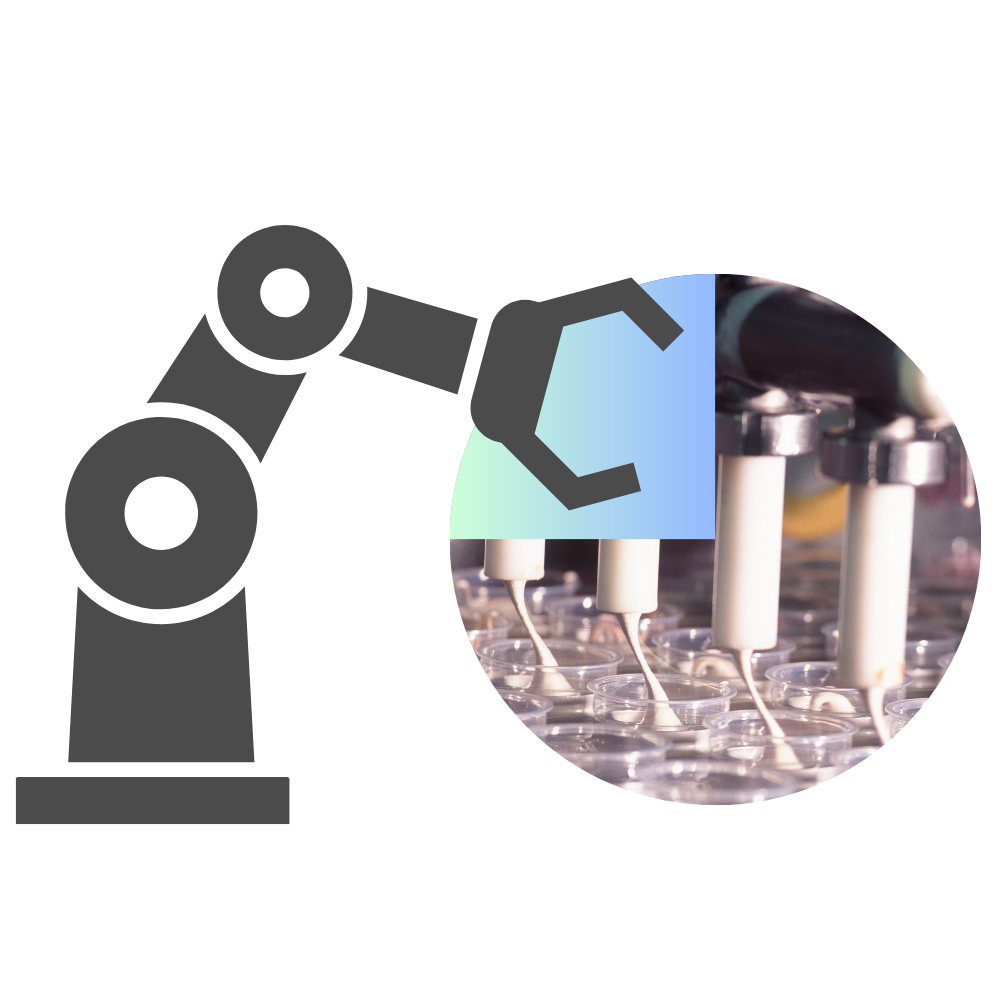
Case Study: Perfecting Ice Cream Innovation
Unilever, a leader in consumer packaged goods, has embraced robotics and advanced manufacturing processes to innovate its product offerings. A notable example is the development of its micro-format ice cream, Magnum bon bons, which required the company to reimagine traditional production methods and ice cream formulations. Leveraging robotics, Unilever enhanced precision and efficiency in creating new miniature treats, ensuring consistent quality and unique product features that cater to a growing market of portion-controlled snacks.
By integrating robotics with AI and 3D printing, Unilever streamlined the manufacturing process, reducing waste and accelerating time-to-market. This forward-thinking approach demonstrates Unilever’s commitment to leveraging cutting-edge technologies to deliver innovative products that cater to evolving consumer preferences.

How Robotics is Transforming Aerospace
Key Impact Areas: Precision Manufacturing, Maintenance Automation, and Space Exploration
Robotics is revolutionizing the aerospace industry by enhancing precision, safety, and efficiency. By the year 2030, robotics will play critical roles in manufacturing, maintenance, and operations, ensuring optimal performance and reducing human error.
- Manufacturing Automation: Robotics will streamline the production of aircraft components, increasing precision and reducing production time.
- Maintenance and Inspection: Autonomous robots equipped with sensors will inspect aircraft for damage, improving safety and minimizing downtime.
- Space Exploration: Robotics will assist in space missions, from performing detailed assessments of system operational readiness to conducting remote scientific research.
Revolutionizing Oil and Energy with Robotics
Key Impact Areas: Safer Pipelines, Renewable Energy Maintenance, Offshore Innovations
In the oil and energy sector, robotics is driving innovation by enabling safer, more efficient operations. Over the next five years, robotics will transform how energy is produced, transported, and maintained, addressing challenges in hazardous and remote environments.
- Pipeline Inspection and Maintenance: Autonomous robots can monitor and repair pipelines, reducing environmental risks and operational disruptions.
- Renewable Energy Operations: Co-bots will enhance the assembly and maintenance of wind turbines and solar panels, increasing sustainability efforts.
- Offshore Operations: Subsea robotics can enable exploration and maintenance of offshore oil rigs, improving safety in high-risk environments.
Sustainability and Energy Efficiency in Robotics
As robotics continues to revolutionize oil and energy, sustainability is becoming a core focus. The next generation of robots is designed not only for performance but also for environmental responsibility:
- Recyclable Materials: Manufacturers are turning to sustainable and recyclable components to reduce the overall environmental footprint of robots used in the field.
- Energy Optimization: Breakthroughs in battery technology and advanced power management systems are making energy-intensive operations more efficient, ensuring robots can perform longer missions with less environmental impact.
- Green Manufacturing Practices: Robotics production is increasingly adopting eco-friendly manufacturing processes, further supporting industry-wide efforts to shrink carbon footprints.
Together, these advancements are aligning robotics with the global push toward renewable energy and responsible technology—helping the oil and energy sectors evolve into safer, cleaner, and more sustainable industries.
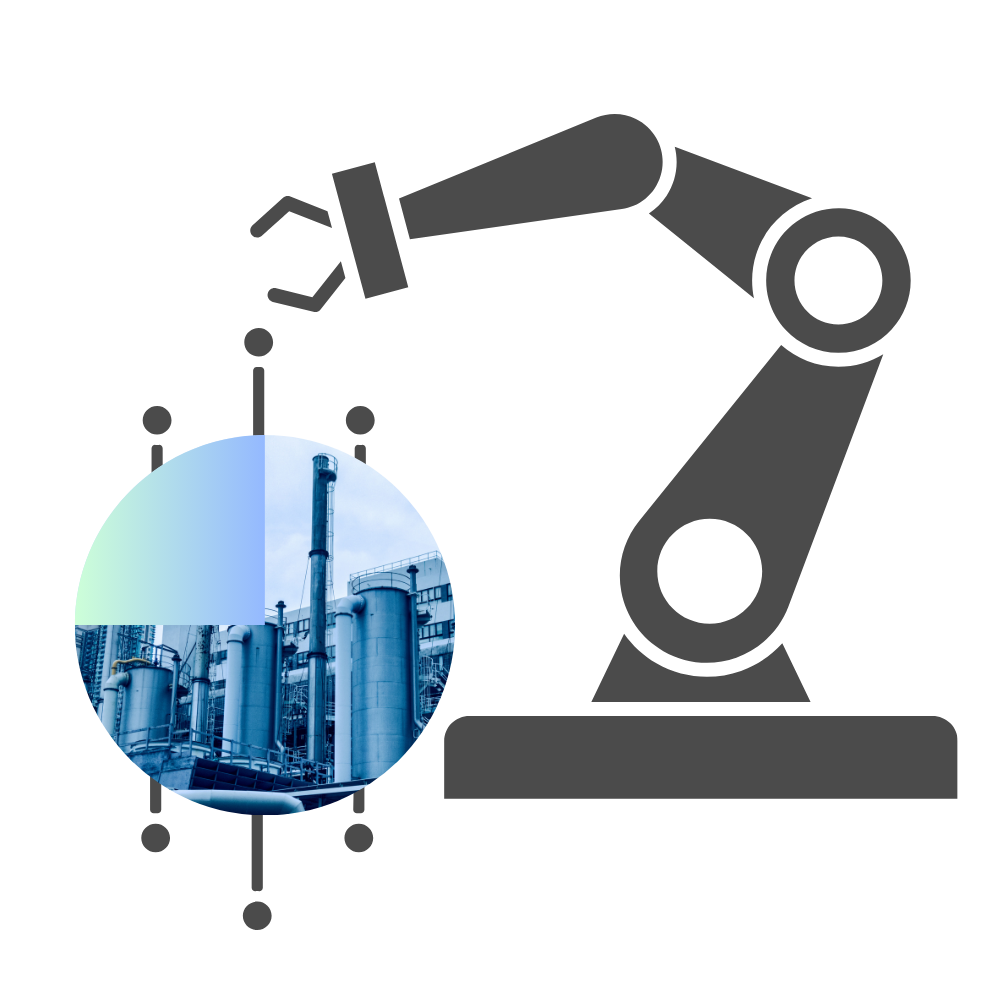
Case Study: Gecko Robotics, Advancing Defense and Energy Sectors
Gecko Robotics, one of Fast Company’s Most Innovative Companies, is an ally to the defense and energy industries with its innovative AI-enabled robots designed for high-precision inspections and maintenance. Their advanced AIR robots and software platform Cantilever are equipped with state-of-the-art sensors and AI-driven analytics, enabling them to assess the structural integrity of critical assets like naval ships, submarines, and power plants.
In the defense sector, Gecko’s technology enhances the efficiency and safety of maintaining naval vessels, ensuring readiness for deployment while reducing risks to human inspectors. Similarly, in the energy sector, these robots are used for inspections in power plants and oil and gas facilities, identifying vulnerabilities and extending the lifespan of critical infrastructure. Gecko Robotics is setting a new benchmark for precision, safety, and cost-effectiveness in industries where reliability and leading technology are paramount.

Advancing Life Sciences and Healthcare Through Robotics
Key Impact Areas: Lab Automation, Pharma Manufacturing, Surgical Robotics, Healthcare Operations
Robotics is set to revolutionize the life sciences industry by advancing research, production, and patient care. Over the next five years, AMRs and co-bots will enhance laboratory workflows, pharmaceutical manufacturing, and personalized medicine. They will also assist healthcare staff within clinical settings.
- Laboratory Automation: Robots will handle repetitive tasks, improving accuracy and freeing up researchers for high-level analysis.
- Pharmaceutical Production: Solutions will support the efficient and sterile manufacturing of medications, ensuring regulatory compliance.
- Surgical Assistance: Advanced robotics will provide precision during surgeries, reducing recovery times and improving patient outcomes.
- Healthcare Co-bots: Mobile robot systems ease manual tasks and minimize physical strain on workers.
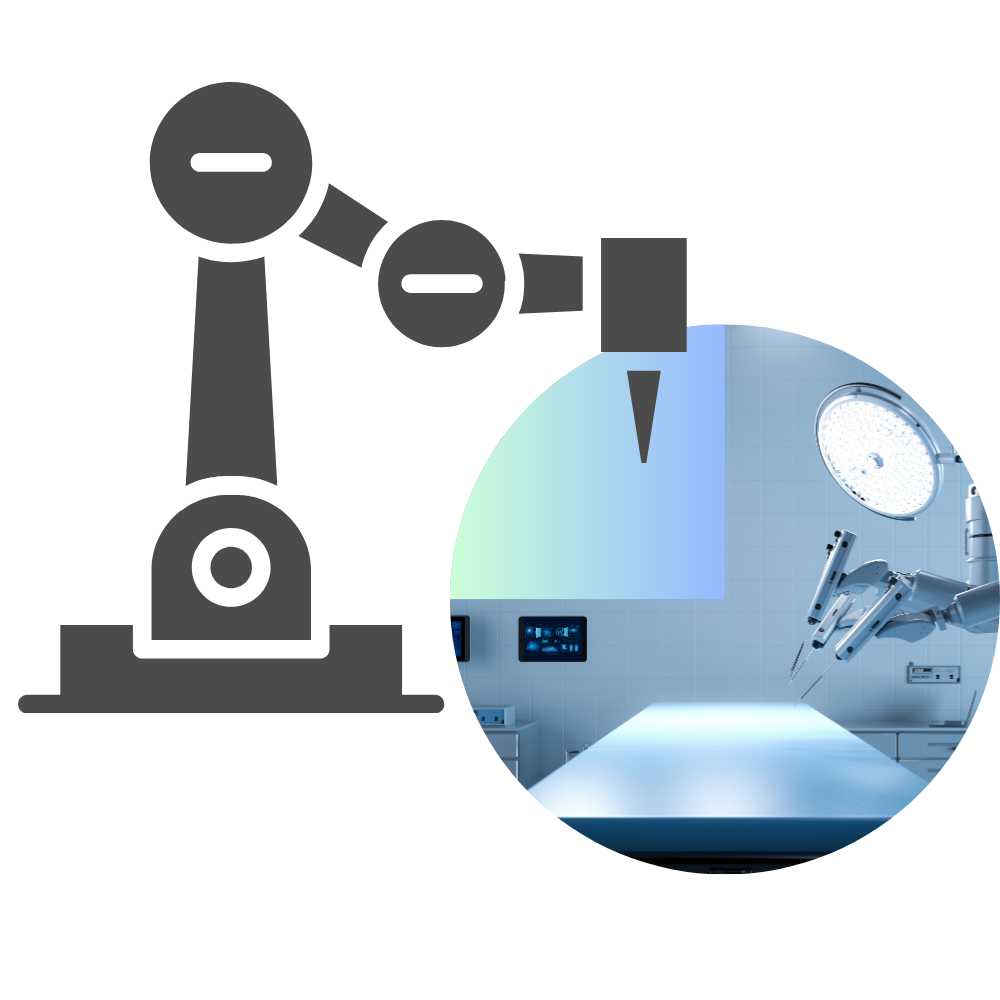
Case Study: Chang Robotics for Improved Healthcare Operations
Autonomous Mobile Robots (AMRs) are an emerging part of the medical team, independently navigating hospital environments and working alongside healthcare professionals to enhance productivity and efficiency. These co-bots handle repetitive and time-consuming tasks, such as transporting materials or supplies within hospitals, allowing nurses to focus on critical patient care. Companies like Chang Robotics are at the forefront, designing custom AMR solutions tailored to specific needs, including specialized fixtures, making these robots versatile tools for improving operations in healthcare and beyond. For additional advances, refer to their white paper Robotics and Automation in Healthcare: Current State and Promising Advances.

Industrial Robotics in Chemical and Material Manufacturing
Key Impact Areas: Precision Handling, Task Automation, Supply Chain Optimization
Manufacturing industries are swiftly adopting a variety of robotics to enhance precision, efficiency, and safety. In the next five years, the speed, safety, and accuracy of industrial robots, autonomous mobile robots (AMRs) and co-bots will streamline production processes and improve workplace safety.
- Precision Handling: Robotics will enable accurate mixing and handling of chemicals, reducing waste and enhancing product quality.
- Hazardous Task Automation: Robots will perform tasks in environments too dangerous for humans, such as handling toxic materials or operating in high-temperature zones.
- Supply Chain Optimization: AMRs will optimize the movement of raw materials and finished goods within facilities, increasing efficiency.
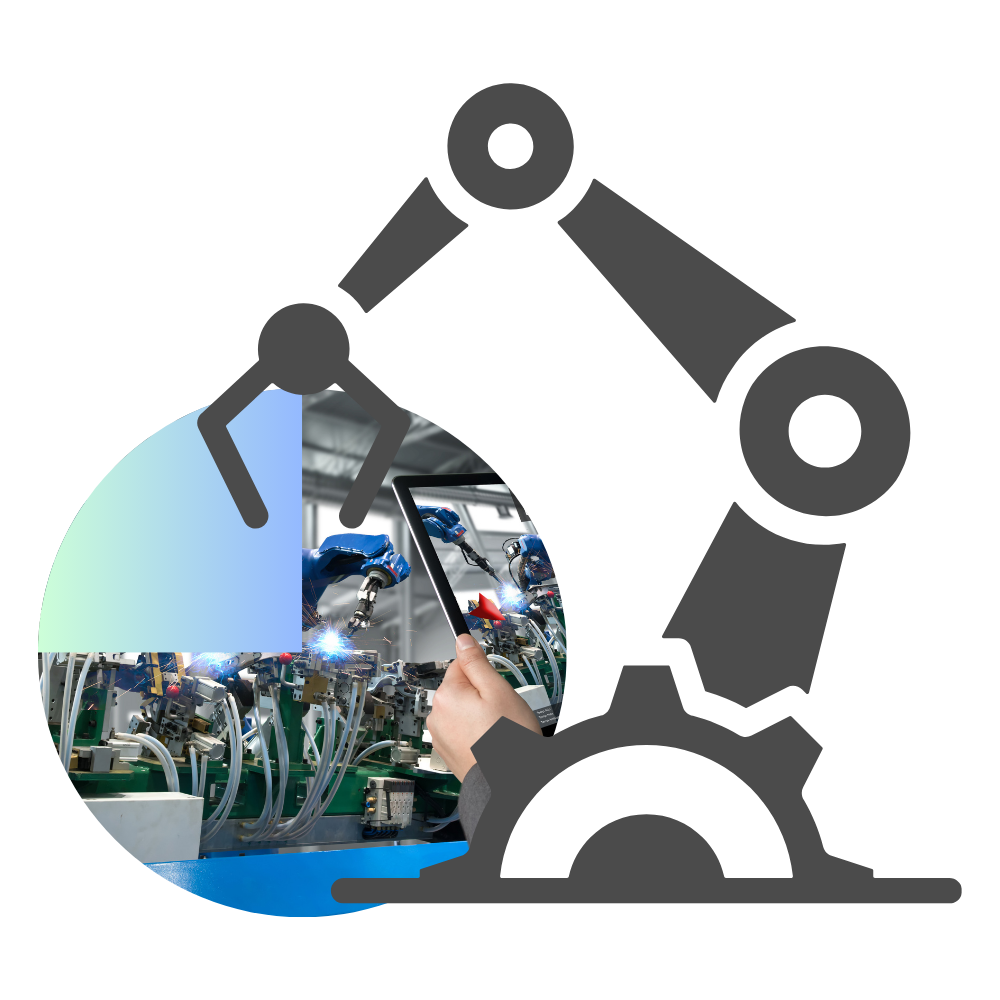
Case Study: FANUC Robotics for Manufacturing
FANUC America, a leader in robotics and automation, has expanded its operations with a new $110 million, 650,000-square-foot West Campus facility in Michigan. This investment supports the increasing demand for automation solutions across industries, including chemical and materials manufacturing, where FANUC’s advanced technologies enhance production efficiency and precision.
FANUC emphasizes the growing role of collaborative robots with its CRX series, designed to work alongside human operators to boost safety and increase productivity. They are ideal for various manufacturing applications, from welding to assembly to packaging, in most sectors including chemicals, materials, and electronics. This company also leads in innovations such as laser solutions, which offer unmatched precision and versatility for advanced manufacturing processes. By integrating these cutting-edge technologies, FANUC demonstrates its commitment to driving productivity, efficiency, and innovation across diverse industries.

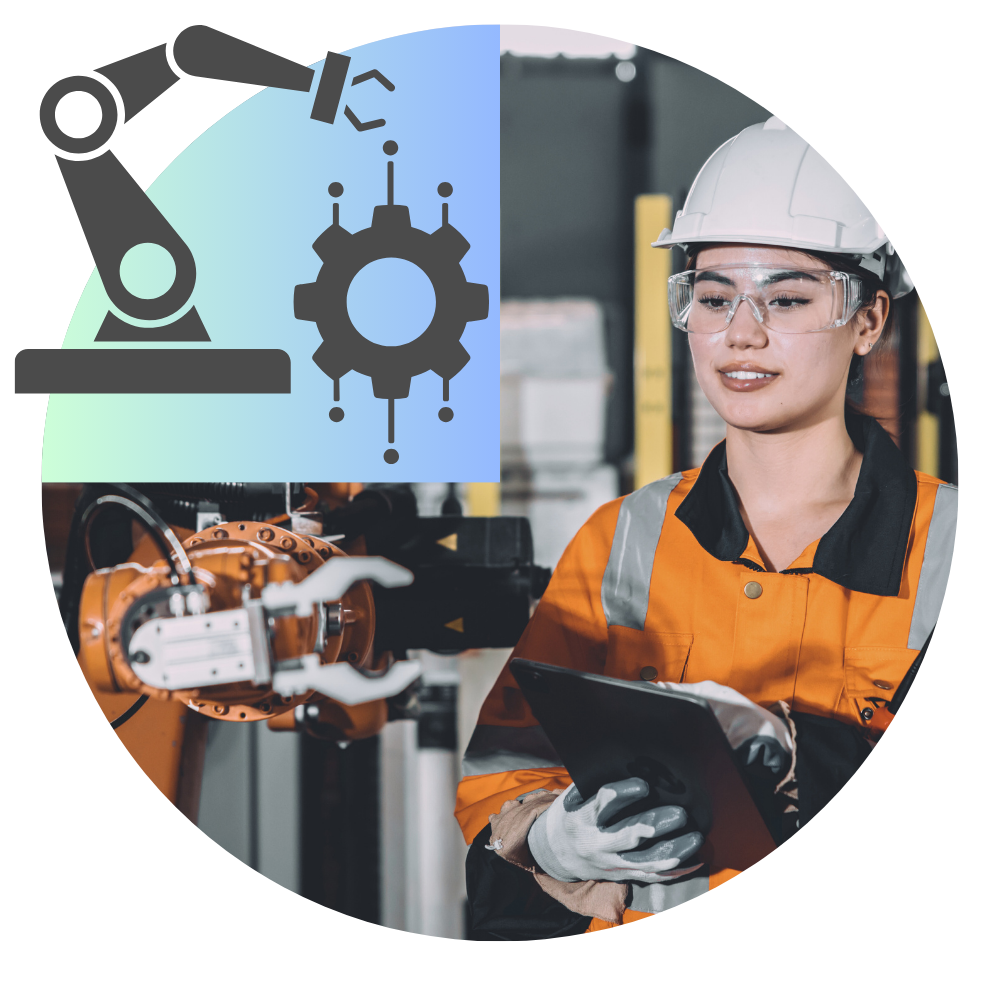
Upskilling the Workforce for Robotics and Automation
As advanced manufacturing becomes increasingly reliant on technologies like AI, robotics, and automation, companies must ensure their workforce is prepared to adapt. Continuous upskilling and reskilling are essential for employees to stay competitive and meet evolving industry demands.
By fostering an innovative culture, organizations can equip their workers with the skills needed to thrive alongside cobots and other emerging systems. This could involve integrating training programs focused on new digital tools, programming languages, and robotics applications. In addition, companies should aim to instill and incentivize a desire for continuous interdepartmental learning as well as provide a knowledge repository for collective intelligence.
Upskilling initiatives allow employees to develop expertise in areas like sensor integration, machine vision, and autonomous navigation. Reskilling also enables workers to transition into new roles, such as robotics technicians or automation specialists, as manual tasks become automated.
Ultimately, investing in the adaptability and versatility of the workforce is crucial for manufacturers to remain productive and innovative amid rapid technological change. Companies that prioritize continuous learning will be best positioned to capitalize on the benefits of advanced robotics while minimizing disruption to their operations.
Looking Ahead: The Evolving Role of Robotics Beyond 2025
Looking beyond 2025, robotics will move well past today’s benchmarks—reshaping industries with unprecedented levels of intelligence, adaptability, and environmental responsibility. The convergence of artificial intelligence, digital twins, and flexible automation will fundamentally change the way businesses design, produce, and deliver products.
Here’s what we can expect on the horizon:
- Greater Customization: Robotics will support agile manufacturing, allowing companies to rapidly reconfigure production lines for personalized orders—without sacrificing speed or quality.
- Intelligent Collaboration: Co-bots and advanced AI-driven robots will seamlessly integrate with human teams, enhancing workplace safety and efficiency while enabling workers to focus on higher-value, creative tasks.
- Sustainable Solutions: New generations of robots will be more energy-efficient, leverage recyclable materials, and help companies achieve greener supply chains by reducing waste and unnecessary movement.
- Data-Driven Optimization: By harnessing the power of digital twins and real-time analytics, organizations will gain clearer insights into operations, enabling smarter decision-making, predictive maintenance, and ongoing process improvements.
As robotics continue to mature, their evolving capabilities will help unlock new business models, fuel operational resilience, and drive a more sustainable industrial future. Forward-thinking organizations that strategically embrace these advancements will be well-equipped to lead in the coming decades.
Take the Next Step in Your Innovation Journey

As robotics and automation continue to reshape industries from manufacturing to defense to healthcare, organizations must strategically position themselves to harness these transformative technologies. Implementing co-bot solutions isn’t just about staying competitive—it’s about leading the way in innovation and operational excellence.
Ready to explore how emerging robotics technologies can benefit your organization?
Our Technology Scouting and Innovation Analyst Teams help you navigate this rapidly evolving landscape. We provide:
- Custom research reports tailored to your business
- Strategic innovation pipeline management tools
- Data-driven project prioritization metrics and guidance on implementation roadmaps
Contact us today to discuss your R&D objectives and transform your innovation strategy for the automated future ahead.

